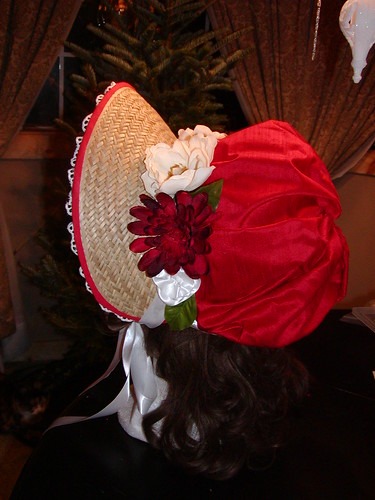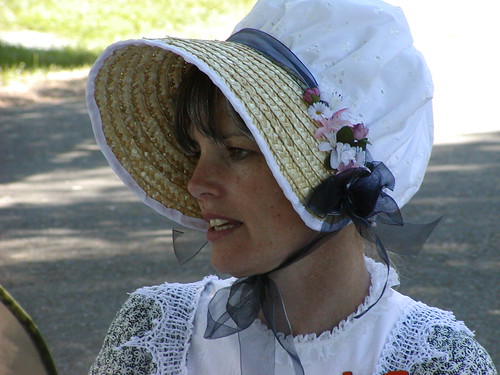 I know, it’s very soon to post a new topic, but I was sketching today, and found myself doing a little study of Regency stays--thinking about perhaps making myself a new set just for riding. So this is my new post. ;)
I know, it’s very soon to post a new topic, but I was sketching today, and found myself doing a little study of Regency stays--thinking about perhaps making myself a new set just for riding. So this is my new post. ;)I gave away my customized transitional stays (click here to see photo journal of the project) to my dear friend because frankly, it fits her better. So did my 2008 Winter Ballgown… that brat.
I digress… So I started thinking about making a new set, and started looking at patterns, and I realized I hadn't done a good comprehensive post about Regency corsetry at all, and it was due time.
The Regency stay is unique in historical corsetry because it is one of the very few periods where the corset was designed for something other than shaping the torso/waist. The Regency corset was a lifting device; and it was designed to present a lady’s assets on a proverbial platter. The gown was supposed to fall in a long, columnar line below the empire waistline.
In my few years of pursuing projects in the period costume, I've learned a lot about making Regency pieces, so please read these tips if you haven't done any corsetry yet:
An important truth you must know in corset and stay-making… boning is not meant to hold you. All boning is meant to do is to keep the fabric of the garment taut and to prevent it folding or wrinkling. The *cut* of the corset is where the shape comes from…. And in the case of the regency corset, the gusseting is key. Gussets are not fun to do, but they are crucial in shaping your ‘platter’ to suit your assets, and in setting the long stays on your hips so that the rest of the taught fabric will continue to hold you while you go about your day.
A busk is a flat, wooden stick that helps to keep the front of a corset straight, tight, and keeps your gusset cups upright and separated. It was sometimes known that gentlemen would carve and smoothen a busk, and etch his nam into it for their favourite lady so she could wear his handiwork close to her heart. How romantic. :) The busk slides into a narrow, long pocket sewn into the front of your stay.
If a regency corset is made correctly to fit its wearer, you should never be so tightly trussed up that you are uncomfortable; as you would be in a corset from another period. A Regency corset should act as a really great supporting miracle-bra; and for some lucky ladies, that is all they might need. A miracle bra.
So, for those of us who cannot get away with just using a miracle bra to acheive the desired Regency silhouette... here is a breakdown of the period's corsets, some sample images and some pattern recommendations. If you know of good patterns, not mentioned here, please feel free to add links in your comments.
So, for those of us who cannot get away with just using a miracle bra to acheive the desired Regency silhouette... here is a breakdown of the period's corsets, some sample images and some pattern recommendations. If you know of good patterns, not mentioned here, please feel free to add links in your comments.
The three general categories of Regency stays:
* The Short Stays *
 The short stay is in essence, the miracle bra of the regency period. It is small, and reasonably comfortable.
The short stay is in essence, the miracle bra of the regency period. It is small, and reasonably comfortable.
Best suited for these body types:
- Smaller cup sizes. Not recommended for anyone above a C-cup; despite the option of going to a D on most patterns. Large breasts often push the front-closure forward, and the lack of busk or length causes the boning to angle into your chest, it can be uncomfortable, and look less than flattering. Recommend transitional or long stays for larger cup sizes.
- Smaller body sizes. I don't recommend this corset if you are a plus-size fit. The boning just is not compatible with any padding on the tummy.
Difficulty:
Easy to make as stays and corsets go. It was actually my FIRST costume project for the ORS. I was daunted at first, but once I got three layers together, I was very proud of myself to find how nicely everything sort of fell together. A beginner could pull this one off, with determination.
Easy to make as stays and corsets go. It was actually my FIRST costume project for the ORS. I was daunted at first, but once I got three layers together, I was very proud of myself to find how nicely everything sort of fell together. A beginner could pull this one off, with determination.
Recommended patterns for short stays:
- Reconstructing History (if you want to try the Kyoto Brassiere Reproduction)
Boning:
- Minimal boning required
- Boning recommendation: zip ties, spiral steel.
Hovering between short and transition stay is the Kyoto Museum's wrap-around brassiere. This is an unusual design, and there is a pattern available for you to try (link provided above).

Kyoto Museum Regency Brassiere

* The Transitional Stays *

- Cup size: Medium to larger cup-sizes (C & D+)
- Body size: Small, medium to thicker body sizes. If you are a bit rubenesque, you might find that the boning on the front might cut a bit into your belly when you sit, and the belly might push the boning up when you sit as well as well, further pronouncing your ‘platter’.
 Difficulty:
Difficulty:Definitely more involved a project, mostly because most transitional stays have tabs or are wraparound projects. A beginner could pull this one off, with determination and care, but it’s definitely a project recommended for intermediate sewers.
Recommended patterns for transition stays:
- Past Patterns
- Reconstructing History
- Daffodown Dilly Regency Era Wrap (for the less-traditional mid-sized stays--scroll down to undergarments section). It is a brilliant design and excellent pattern. I’ve seen completed projects and it’s a wonder, and the pattern designer is accessible and always happy to assist with questions.
- Minimal to moderate boning, depending on your preferences.
- Boning recommendation: cording, caning, zip ties or spiral steel.




The Daisy wrap-around stays
* The Full Stays with Busk *

Best suited for these body types:
- Cup size: Pretty much any-sized cup with the right gusset-work and shaping.
- Body size: From thin to curvy this corset suits them all. The busk is a wonder for the fuller-figured, more-endowed woman. I recommend this corset to all. It’s not half as complicated to make as you think, however you can challenge yourself with it by doing some intricate cording to make it really a work of art. Here is a helpful tutorial on how to do cording from Jennie LaFleur.


 Difficulty:Definitely more involved a project, but easier than the wrap-arounds and the tabbed transitionals. A beginner could pull this one off. Seriously. An advanced seamstress could make it amazing.
Difficulty:Definitely more involved a project, but easier than the wrap-arounds and the tabbed transitionals. A beginner could pull this one off. Seriously. An advanced seamstress could make it amazing. Recommended patterns for Corset:
Boning:
- Minimal to extensive boning/cording, depending on your preferences.
- Boning recommendation: cording, caning, zip ties, light steel or spiral steel.
The Shift
Achieving a Proper Fit
In order to fit your corset or stays well, you should probably read this post on fitting before you begin construction of your stays. It will help you make sure that the stays you choose are helping you achieve the proper silhouette.
I hope this little post will help you decide what works best for you, and also inspires you to make your own stays, they are not as difficult as you imagine, and you can customize them to be something extraordinary if you want. Good luck, leave comments and don't hesitate to ask questions... I'd be happy to help. ;)










































